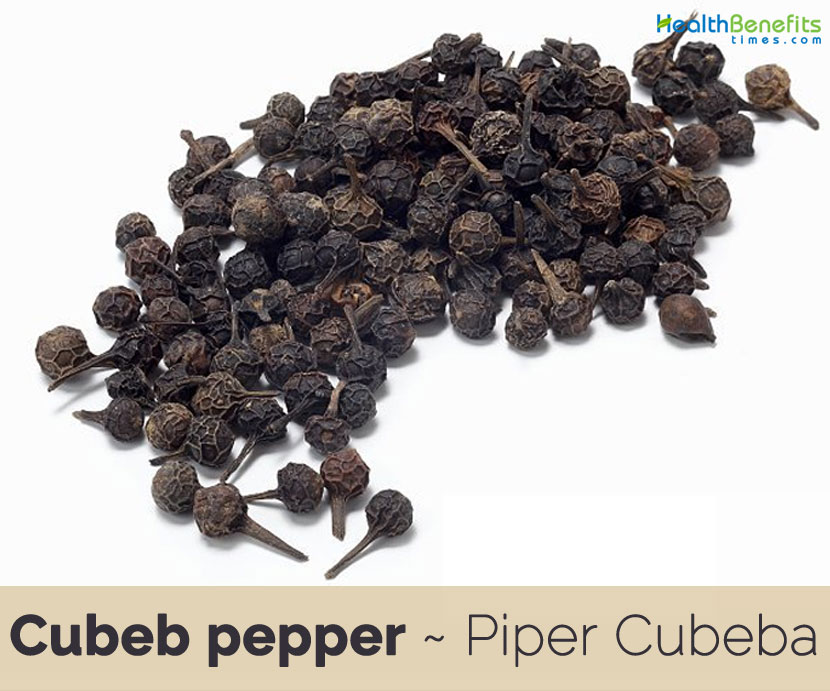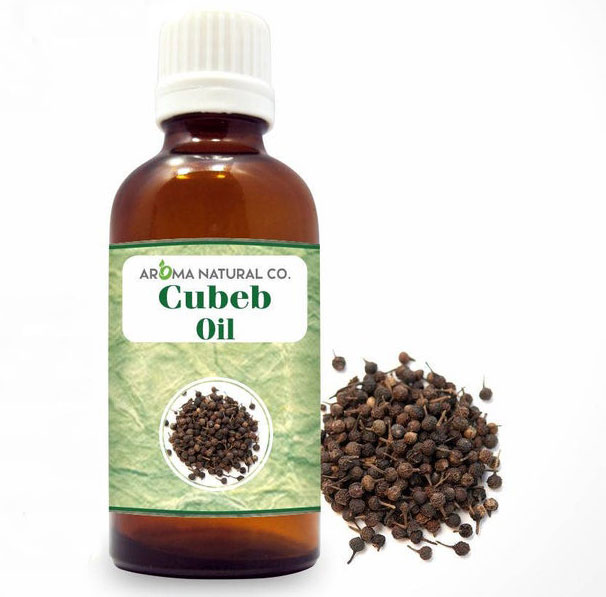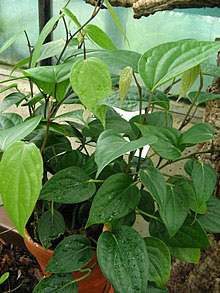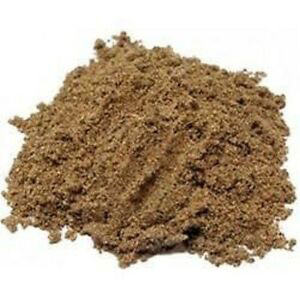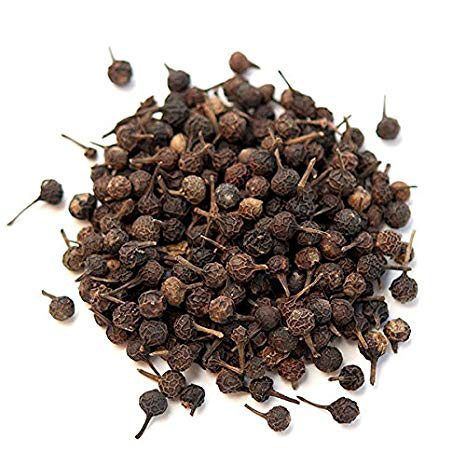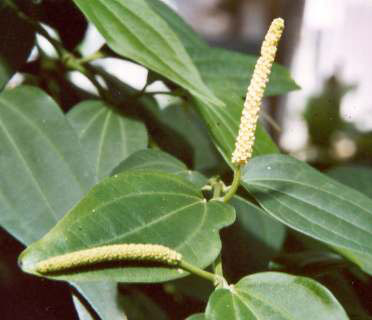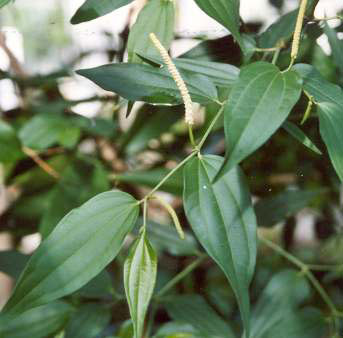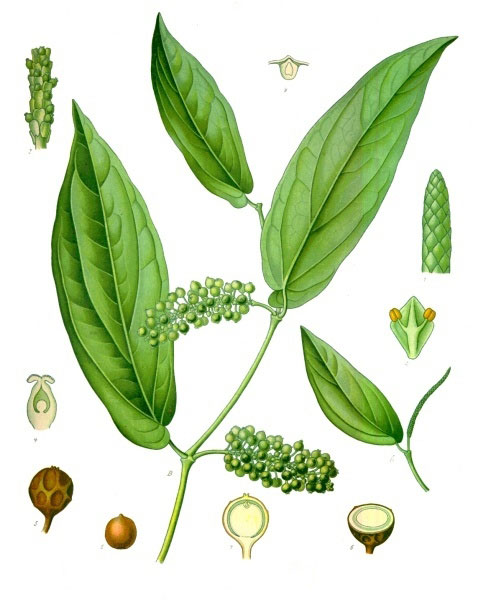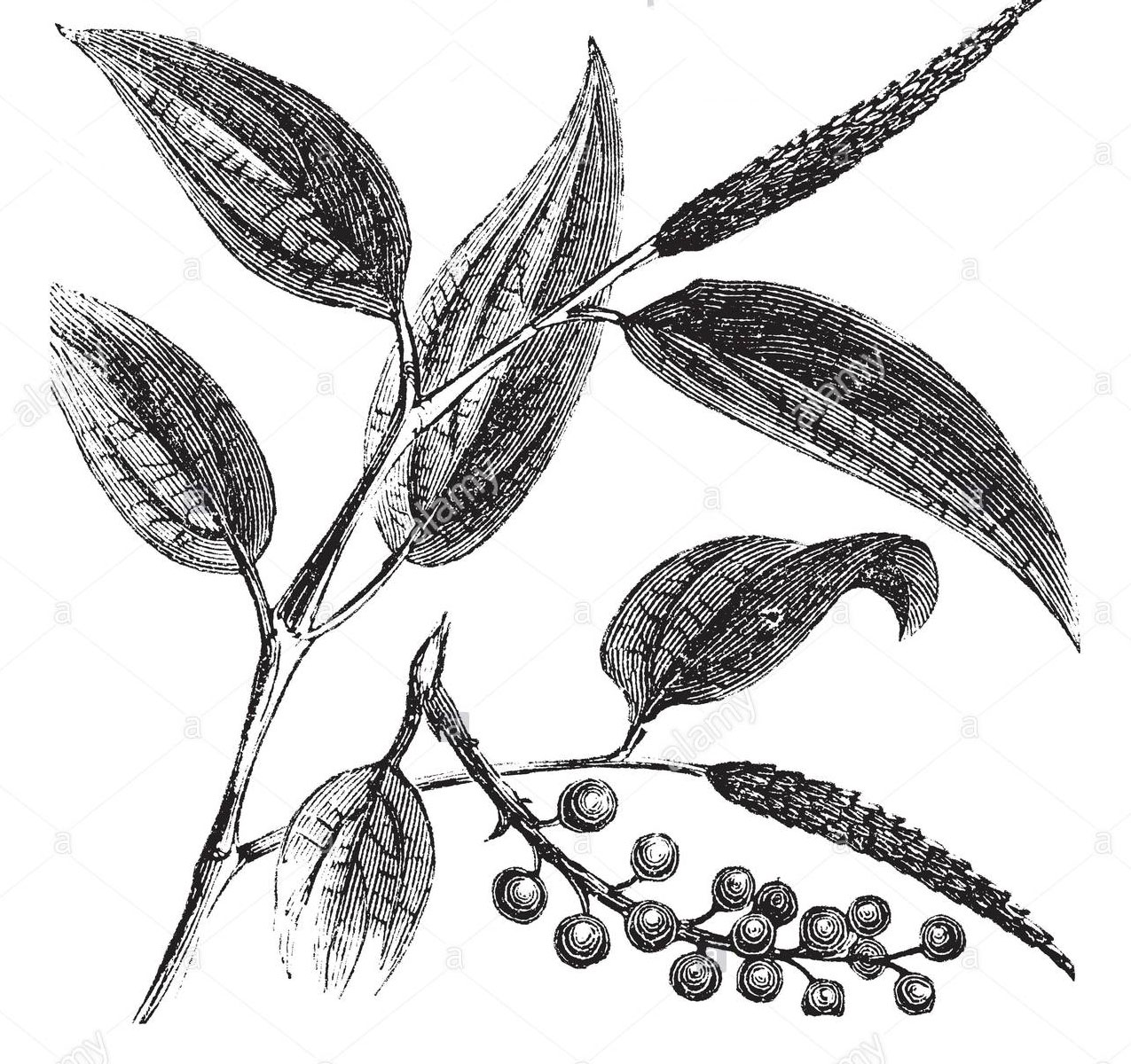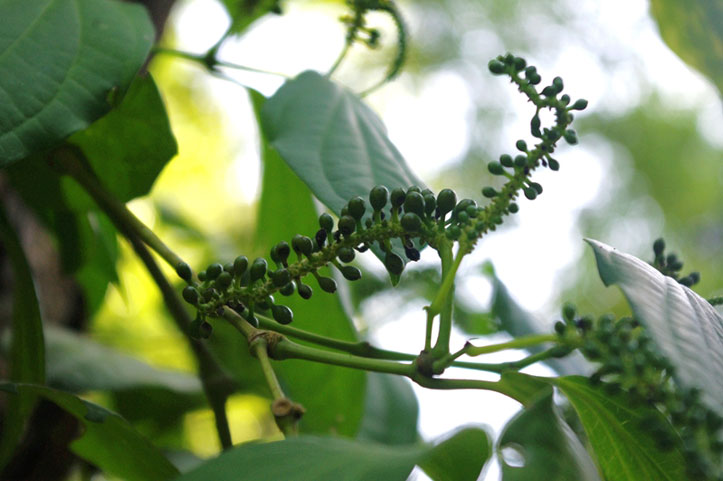| Cubeb pepper Quick Facts |
| Name: |
Cubeb pepper |
| Scientific Name: |
Piper Cubeba |
| Origin |
Indonesia – Greater Sunda Islands. It is cultivated in Java, Sumatra, Malaysia and Sri Lanka |
| Colors |
Green when young turning to yellowish red as they matures |
| Shapes |
Globose, berry, 0.6–08 cm across, smooth, wrinkled when dried, hard, one seeded (globose) and stalked
|
| Taste |
Pungent, somewhat bitter, acrid |
| Health benefits |
Cold & Cough, Inflammatory diseases of the urinary tract, Natural anti-inflammatory, Gastritis and digestion, Good for headache, Respiratory conditions and chronic bronchitis, Fever medicine, Mouth Odor, Overcome fatigue, Influenza |
Piper cubeba, the dried ripe berries commonly known as Cubeb Pepper, Cubeb has been used in traditional medicines for various disorders like urogenital diseases, gonorrhea, dysentery, syphilis, abdominal pain, diarrhea, enteritis and asthma. It is a member of the piper family, cousin to piper longum and piper nigrum, better known as black and white pepper. The dried, wrinkled cubeb berries are similar in appearance to peppercorns, though grayish-brown in color. Their thin stalks, or “tails” that remain attached, give the fruit its nickname of “tailed pepper.” Its flavor is described as a cross between allspice and black pepper. The plant is native to Indonesia – Greater Sunda Islands. It is also cultivated in Java, Sumatra, Malaysia and Sri Lanka. Few of the popular common names of the plant are Cubeb pepper, Java pepper, Javanese peppercorn, West African black pepper, cubeb, Jawa peppercorn, Jawanese pepper, Tailed pepper, Cubeb, False Pepper and Javanese Pepper.
The name cubeb comes from Arabic kabāba (كبابة) by way of Old French quibibes. Cubeb is mentioned in alchemical writings by its Arabic name. In his Theatrum Botanicum, John Parkinson tells that the king of Portugal banned the sale of cubeb to promote black pepper (Piper nigrum) around 1640. It experienced a brief resurgence in 19th-century Europe for medicinal uses, but has practically vanished from the European market since. It continues to be used as a flavoring agent for gins and cigarettes in the West, and as a seasoning for food in Indonesia. This plant grows a lot in Java and Sumatra Island and produces fruit. It is usually harvested before ripe and then dried. Traditionally, cubeb pepper is used as a medication for breath shortness, body warmers, and deodorizing mouth. Because of phenolic, it is often used to stop the infection in the genitals.
Plant description
Cubeb pepper is a perennial, climbing woody shrub that grows around 18 – 20 feet tall. The plant is found growing in full or partial shade in the moist deciduous tropical forests, edges of mangrove forest, also found along streams, forest tracks and margins. The plant grows best in a rich, fertile, well-drained soil. Stem is glabrous, jointed, cylindrical and striate stem somewhat thickened at the nodes and rooting at the nodes.
Leaves
Leaves are alternate, on short stout petiole, blade is about 6 inches long, lanceolate or oval oblong, tapering to the acute apex, usually somewhat unequal at the base, quite entire, slightly wavy, glabrous on both surfaces, somewhat coriaceous, deep green rather paler and prominent vein beneath.
Flower
Flower is unisexual, dioecioues, minute, sessile, each with a bract at the base, densly crowded in small, cylindrical, stalked, solid spike coming of opposite the leaves. The male spikes are slender, tapering, shortly stalked, about an inch long and the female are shorter, blunt, thick and fleshy, on longer stalks.
Fruit
Fertile flowers are followed by globular smooth berry, about ¼ inch long, with a blunt apiculous and tapering below into a stalk –like base, which a little longer than round extremity, projecting horizontally from the axis and together forming a lax raceme ( many of the ovaries becoming abortive) about 2 inches long. Fruits are green when young turning to yellowish red as they mature.
Health benefits of Cubeb pepper
Dried cubeb berries consist of an essential oil that contains monoterpenes and sesquiterpenes. The terpenes contained in the berries of the plant have anti-inflammatory and anti-bacterial properties. Cubeb helps to relieves headaches and dizziness, serves as an aphrodisiac and promotes concentration. Mortared cubeb pepper powder has a stimulating effect when smoked. Listed below are some of the popular health benefits of consuming Cubeb pepper
1. Inflammatory diseases of the urinary tract
Due to its anti-inflammatory effect, Cubeb pepper was traditionally used for infections of the urogenital tract (kidney inflammations, bladder catarrh, and ureter infections, prostate and uterine inflammations).
2. Gastritis and digestion
Cubeb peppers are also used to treat gastritis or to strengthen the gastrointestinal tract. Cubeb pepper promotes digestive activity by stimulating salivation and the production of gastric juices. Cubeb is especially potent after eating high-fat and hard to digest meals.
3. Respiratory conditions and chronic bronchitis
Indian folk medicine (Ayurveda) recognizes the mucus-dissolving properties of this age-old medicinal plant. Cubeb pepper remains in active use in Ayurveda today as a cough-suppressant for mild bronchitis, nagging cough, and generally to address respiratory symptoms.
4. Influenza
This plant seed is used as a cold medicine for babies. Mash 1 lesser galangal and 9 cubeb seeds, mix with a little water. Apply this paste to baby’s body.
5. Overcome fatigue
To increase body energy, provide some natural ingredients from cubeb. Take 5 clove seeds, 5 cubeb seeds, 1 lemongrass, 4 lime leaves, ½ ginger rhizomes, a pinch of cinnamon, ½ nutmegs, and a little sugar. Slice all ingredients, and then boil with 5 glasses of water. Wait until the water is reduced to 2 glasses. Strain and drink when the water is still warm, 3 times a day.
6. Mouth Odor
Cubeb is very aromatic and has antiseptic properties so it is has been used for dental problems for many years and it is particularly very useful for halitosis (mouth odor). You can read the research that proves this use here.
7. Fever medicine
If you are looking for a natural fever remedy, then the cubeb is the right choice. Natural content in healthy seeds is powerful to reduce body heat when the fever comes.
8. Medicine for a headache
Overcome the pain in your head by using the cubeb. Seeds can cure headaches, dizziness, and other symptoms such as headaches or a migraine.
9. Natural anti-inflammatory
Inflammation of your body can be overcome with cubeb. This seed has a natural anti-inflammatory function, which is a health function that can relieve inflammation in your body and reduce the pain caused by the inflammation.
10. Cold & Cough
Cubeb is one of the best ingredients to take during cold and cough and even during mild fevers as it has anti-pyretic properties. We take it in the form of tea along with holy basil and turmeric powder. It is very soothing to drink when we suffer from cold and it also relieves headache.
Ayurvedic Health benefits of Cubeb
- Asthma: Take some pieces of Cubeb. Put in a cigarette paper. Smoke once a day.
- Bronchitis: Inhale the smoke of cubeb once a day.
- Hay Fever: Burn some Cubeb pieces. Breathing in the smoke.
- Cough: Take some Cubeb. Roast and powder them. Have a pinch with honey or lukewarm water thrice a day.
- Sore Throat: Roast some Cubeb. Powder them. Take a pinch with honey twice a day.
- Hoarseness: Powder the some Cubeb. Mix a pinch in a cup of hot milk and take it every night.
- Indigestion: Soak half teaspoon Cubeb in a glass of warm water for 5 minutes. Have twice a day.
- Stomach Diseases: Make infusion of Cubeb. Take twice or thrice a day. OR add 5 drops of Cubeb oil on a sugar cube. Eat once a day.
- Toothache: Add 5 to 10 drops of oil in a glass of lukewarm water. Swish twice a day.
- Bad breathe: Take a glass of slightly warm water. Add 5 drops of Cubeb oil. Swish with it twice or thrice a day. OR make infusion of Cubeb. Swish with it.
- Vaginal Discharge: Take 25 gram Cubeb. Soak in One liter water for half an hour. Use it as douche.
- Gum Disease: Grind 1 cup each of the bark of Acacia Nilotica and Azadirachta Indica. Add 1 tablespoon each of powdered Cubeb, Long Pepper and Rock Salt. Use after Every meal as a tooth powder.
- Constipation: Grind Carom, Asafoetida, Cardamom, and Cubeb separately. Extract one cup Bitter Apple juice. Take 1/4 teaspoon powder of each herb. Mix all in juice. Add rock salt according to your taste. Drink half in the morning and half at night for 7 days. (Caution: Excess may cause Vomiting and Nausea.)
- Bronchitis: Take equal quantity of Cubeb and Cinnamon. Powder them. Put a pinch of powder in a glass of water and leave it for 5 minutes. Drink it daily.
- Cough: Take a pinch of each, Cubeb powder and Cinnamon powder. Soak in a glass of water for 2 to 3 minutes. Have it once a day.
- Bronchitis: Take equal quantity of Cubeb, Galangal, Licorice and Long Pepper. Grind them together. Boil two teaspoon powder in a cup of water. Add two teaspoon Honey and have lukewarm daily.
- Cough: Grind equal quantity of Cubeb, Galangal, Licorice and Long Pepper. Take one teaspoon with two teaspoon Honey daily.
- Cold: Grind equal quantity of Solanum Xanthocarpum and Cubeb roots. Boil 2 pinches powder in one cup water. Add one teaspoon Honey. Drink lukewarm once a day.
- Cough: Take one pinch each of Solanum Xanthocarpum roots powder and Cubeb powder. Boil in one cup water. Add one teaspoon Honey. Have it lukewarm.
- Phlegm: Powder Solanum Xanthocarpum and Cubeb roots. Take 2 pinches of the prepared powder with Honey for 3 days
- Menstrual Disorders: Mix equal quantity of Indian Snake root powder with Cubeb powder. Take quarter tsp. of the mixture twice a day. (Attention: Do not consume if you are Pregnant.)
- Snake Bite: Mix root powder of Indian Snake root with Cubeb powder. Take 2 tsp. of the mixture and add half tsp. Salt. Apply it over bitten area. You may use it internally.
- Cough: Pound cubeb in a mortar and pestle very finely. Take 2 pinches of the pounded mixture mixed along with honey.
- Dandruff: For dandruff, we make a hair oil using unrefined sesame oil, fenugreek leaves, cubeb and haritaki, very effective for treating all scalp infections. It can use as a pre shampoo treatment.
- Mouth Wash: For the mouth wash, boil 1/4 tsp. of pounded cubeb along with 1 small broken Ceylon cinnamon and a cup of water for a few minutes and strain. Use it as a mouth wash.
- Mild Fever & Indigestion: For treating mild fevers and indigestion, take a handful of holy basil leaves and slightly pound them along with 1/8 tsp of cubeb. Take the pounded mixture, 1/4 tsp. organic turmeric powder and a cup of water in a bowl and boil till it reduces in half, strain and add honey to taste.
- Piles: Take 1/2 teaspoon of piper cubeb powder, twice a day with warm cup of milk. If constipated, use trihala churna.
- Dysuria, painful urination: Take 1/2 teaspoon of piper cubeb powder with misri/sugar candy, in morning and evening.
Traditional uses and benefits of Cubeb pepper
- Cubeb pepper is a popular medicinal plant which has been extensively used in Europe since the middle Ages, as well as in many other countries, including Arabia, India, Indonesia, Malaysia and Morocco in traditional medicine.
- Cubeb berry is considered a carminative, diuretic, expectorant, stimulant, stomachic, anti-asthmatic, irritant, sedative, anti-dysenteric and antiseptic.
- It acts particularly on mucous tissues, and arrests excessive discharges, especially from the urethra.
- Cubeb berry also has a local stimulating effect on the mucous membranes of the urinary and respiratory tracts.
- It exercises an influence over the urinary apparatus, rendering the urine of deeper color.
- It has been used in the treatment of gonorrhea, gleet, leucorrhoea, chronic bladder diseases, acute prostatitis bronchial affections, dysentery and in spermatorrhea.
- In England, various preparations of cubeb including oleum cubebae (oil of cubeb), tinctures, fluid extracts, oleo-resin compounds, and vapors, were employed for throat complaints.
- Cubeb was commonly included in lozenges designed to alleviate bronchitis, exploiting the antiseptic and expectoral properties of the drug.
- Most important therapeutic application of cubeb, however, was in treating gonorrhea.
- Cubeb berry has been shown to be effective in easing the symptoms of chronic bronchitis.
- Cubeb paste is used as a mouthwash, and dried cubeb is used internally for oral and dental diseases, loss of voice, halitosis, fevers, and cough in India.
- It is also used for digestive ailments and is effective in treating dysentery.
- Herb has often been related with the reproductive system and has been used to treat cystitis, leucorrhea, urethritis, and prostate infections.
- Unani physicians use a paste of cubeb berries externally of the male and female genitals to intensify sexual pleasure during coitus in India.
- Indian physicians and Arab physician during the Middle Ages use cubeb berries as a main ingredient in an aphrodisiac remedy for infertility.
- Cubeb was used in many medicinal mixtures administered as tonics, indigestion mixtures and pick-me-ups after childbirth and for rheumatism in Malaysia.
- It is also recommended for external application.
- Cubeb berries have also been used for the treatment of abdominal pain, asthma, diarrhea, dysentery, gonorrhea, enteritis and syphilis in Indonesia.
- Cubeb is used in traditional medicine for its warming properties in China.
- Cubeb is one of the six fine herbs in bzang po drug in Tibet.
- It provides relief from painful contraction of the muscle. Thus, it efficiently treats Muscle Cramp.
- It normalizes the digestive functions and strengthens it up, thus, prevents Digestive Problems and Indigestion.
- It expels mucus from the respiratory tract and avoids Respiratory Diseases.
- It relieves Cough.
- It potentially cures Asthma conditions.
- It is a beneficiary remedy to treat Erectile Dysfunction.
- Fruit has an expectorant effect that counters Bronchitis and Laryngitis.
- It is also consumed to remove bad breath from the mouth.
- It serves as a stimulant to protect the body from Leucorrhoea.
- It has a Carminative attribute, which expels the gas from the Intestines and Stomach.
- The Anti-inflammatory property of this herb rapidly heals from the Inflammation within the body.
- It has an Antiseptic attribute that prevents the growth of Microorganisms within the body.
- Aphrodisiac action of this herb increases the libido in both male and female.
- It bears the Anti-emetic characteristics that beneficially work against Vomiting and Nausea.
- Cubeb Tea may help in the treatment of bronchitis and other related respiratory ailments as it is known to help thin mucus.
- Cubeb Tea may help fight infections in the urinary tract.
- Cubeb Tea may help relieve flatulence and bloating of the digestive tract.
- Cubeb Tea is said to be a remedy against infertility. It is also said to help enhance the pleasures of the sexual intercourse.
Culinary Uses
- During the middle Ages, cubeb was one of the most valuable spices in Europe and today its culinary importance has been surpassed by medicinal uses.
- In powdered form cubeb was used as a seasoning for meat and in sauces.
- One common medieval recipe was for sauce sarcenes which is composed of almond milk and spices including cubeb.
- During the fourteenth century, a vinegar referred to as Ocet Kubebowy was infused with cubeb, cumin and garlic and used for meat marinades In Poland.
- Cubeb was often candied and eaten whole as an aromatic confectionery.
- Cubeb is still used to enhance the flavor of savory soups.
- In Moroccan cuisine, cubeb is relished in savory dishes and pastries like mark outs and the renowned spice mixture Ras el hanout a popular mixture of herbs and spices that is used across the Middle East and North Africa.
- Ras el hanout is used in pastilla , the Moroccan squab/young pigeon, and almond pastry, is sometimes rubbed on meats, and incorporated into couscous or rice.
- Cubeb is used as a spice to impart flavor to food in south and Southeast Asia for example in gulés (curries) in Indonesia.
- It is very popular in West African cooking.
- They are sold whole and should be crushed or ground before use in cooking.
- Cubebol an original compound from cubeb oil is traded by a Swiss company as a cooling and refreshing agent and used in various products like chewing gum, drinks, sorbets, gelatin-based confectioneries and even tooth paste.
- Cubeb is also used to flavor alcoholic and non-alcoholic beverages and drinks.
- Bombay Sapphire gin is flavored with cubeb and grains of paradise.
- Pertsovka, dark-brown, Russian pepper vodka with a fiery taste, is prepared from infusion of cubeb and capsicum peppers.
- As an aromatic confectionery, cubeb was often candied and eaten whole.
Other facts
- Cubeb is also used for its fragrance in soaps and perfumes, and can also be found as a flavoring in tooth paste and tobacco (cubeb cigarettes) besides food.
- In 2000, Shiseido Cosmetics Company in Japan patented a line of anti-aging products containing formulas made from several herbs, including cubeb.
- Cubeb berries are used in love-drawing magic spells by practitioners of hoodoo, an African-American form of folk magic.
Precautions
- Taken in excessive doses, cubeb berry can cause nausea, vomiting, burning pain, griping and purging.
- It may cause skin rashes, Nausea and headache.
- Avoid use if having digestive tract inflammation.
- Side effects may include headaches, anxiety, vomiting, urinary tract irritation, kidney and bladder pain, diarrhea and skin rashes.
- People suffering from nephritis (kidney ailments) should never use cubeb.
References:
https://www.itis.gov/servlet/SingleRpt/SingleRpt?search_topic=TSN&search_value=506521#null
https://botanical.com/botanical/mgmh/c/cubeb121.html
https://en.wikipedia.org/wiki/Piper_cubeba
http://mgb.cimmyt.org/gringlobal/taxonomydetail.aspx?id=28578
http://www.theplantlist.org/tpl1.1/record/kew-2557647
http://gernot-katzers-spice-pages.com/engl/Pipe_cub.html
https://gd.eppo.int/taxon/PIPCU
Comments
comments


